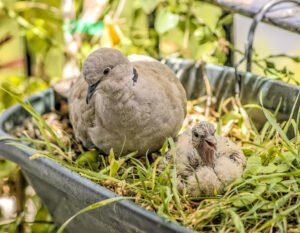1. Rarely Seen
- Baby pigeons are rarely seen because they stay in the nest until they are almost fully grown.
2. Nest Habitats
- Squabs are born in secure, hidden nests often located in high or hard-to-reach areas like building ledges or tree crevices.
3. Yellow Down
- They are covered in yellowish down feathers at birth, which gradually gives way to their adult plumage.

4. Blind and Helpless
- Baby pigeons are born blind and entirely dependent on their parents for survival.
5. Crop Milk Diet
- Both pigeon parents produce a nutrient-rich secretion called “crop milk,” which they feed to the squabs.
6. Fast Growth
- Squabs grow rapidly, doubling their size within a few days of hatching.

7. Long Nesting Period
- They stay in the nest for up to 30 days, longer than most birds.
8. Monogamous Parenting
- Pigeon parents are monogamous, often pairing for life, and both share the responsibilities of raising their young.
9. Hatching Process
- It can take up to 24 hours for baby pigeons to fully hatch from the egg.
10. Two Eggs Per Clutch
- Pigeons typically lay two eggs, and both hatchlings often survive due to attentive parental care.
11. Temperature Sensitivity
- Baby pigeons cannot regulate their body temperature and rely on their parents to keep them warm.
12. No Flight Feathers
- Squabs are unable to fly until their feathers fully develop, around 4–6 weeks old.
13. Dark Beaks
- Baby pigeons have dark, soft beaks that harden and change color as they mature.

14. Feather Pinning
- Their feathers emerge from pin-like structures, a process known as “pinning.”
15. Rapid Weight Gain
- Squabs are among the fastest-growing of all bird species in terms of weight gain relative to their size.
16. Sibling Cooperation
- Squabs in the same nest rarely compete aggressively for food, unlike some other bird species.
17. Bond with Parents
- Squabs imprint strongly on their parents, recognizing them by sight and sound.
18. Early Survival Skills
- Even before leaving the nest, squabs practice flapping their wings to strengthen muscles.
19. Learning from Parents
- Young pigeons learn critical survival skills, such as foraging and navigation, from their parents.
20. First Flights
- Squabs’ first flights are often clumsy, but they quickly master flying after a few attempts.
21. City Adaptation
- Urban squabs are especially adept at adapting to noisy, bustling environments.

Pigeon squabs might be elusive, but their development is fascinating and highlights the adaptability of this bird species.
More about baby pigeons
What to feed your baby pigeon?
Feeding Guidelines for Baby Pigeons
- Age-Specific Diet:
- 0–7 Days Old: Substitute crop milk with a pigeon-specific hand-feeding formula (available in pet stores or online).
- 8–14 Days Old: Gradually thicken the formula as they grow, ensuring proper hydration.
- 15 Days and Older: Introduce softened grains, seeds, or small pellets mixed with water, while continuing formula feeding.
- Proper Feeding Tools:
- Use a syringe with a soft feeding tip or a spoon reshaped into a funnel. Avoid using hard materials that could harm the bird’s beak or throat.
- Consistency of Food:
- The food should have a pudding-like consistency for younger squabs, becoming thicker as they grow older.
- Feeding Frequency:
- 0–7 Days: Feed every 2–3 hours, including at night.
- 8–14 Days: Feed every 4 hours.
- 15+ Days: Reduce feedings to 2–3 times daily.
- Warmth Matters:
- Food should be warmed to body temperature (around 39°C or 102°F). Test it on your wrist to ensure it’s not too hot or cold.
- Avoid Common Foods:
- Do not feed: Bread, milk, raw rice, or salty/spiced foods, as they can harm the squab’s digestive system.
Hydration Is Key
- Ensure the squab is hydrated before feeding. You can give drops of lukewarm water (with a bit of electrolyte solution like Pedialyte) using a syringe.
Tips for Feeding Safely
- Feed slowly and watch for signs of distress.
- Avoid overfeeding; their crop (a pouch in their throat) should feel full but not overly stretched.
- Keep the bird warm; squabs cannot regulate their body temperature.
If you’re uncertain or the pigeon appears unwell, consult a wildlife rehabilitator or avian veterinarian for advice.
If you purchase something through the links on this site, I may earn a small commission—at no extra cost to you! This support helps keep this site ad-free and allows me to continue sharing helpful content with you.




